Serviços Personalizados
Journal
Artigo
Indicadores
-
 Citado por SciELO
Citado por SciELO -
 Acessos
Acessos
Links relacionados
-
 Similares em
SciELO
Similares em
SciELO
Compartilhar
Finisterra - Revista Portuguesa de Geografia
versão impressa ISSN 0430-5027
Finisterra no.98 Lisboa dez. 2014
ARTIGO ORIGINAL
Lisbon heat island statistical study (2004-2012)
A ilha de calor em Lisboa. Estudo estatístico (2004-2012)
Maria João Alcoforado1António Lopes2Elis Dener Lima Alves 3 Paulo Canário4
1 Researcher at CEG-IGOT-ULisboa, research Group ZePHyrUs, editor of Finisterra. Universidade de Lisboa, edifício da faculdade de Letras, alameda da Universidade, 1600-214 Lisboa, Portugal. E-mail: mjAlcoforado@campus.ul.pt
2 Researcher at CEG-IGOT-ULisboa, research Group ZePHyrUs. Edifício da Faculdade de Letras, Alameda da Universidade, 1600-214 Lisboa, Portugal. E-mail: antonio.lopes@campus.ul.pt
3 São Carlos school of Engineering, University of São Paulo, Brazil. E-mail: elisdener@hotmail.com
4 PhD student, researcher at CEG-IGOT-UL, research Group ZePHyrUs. Edifício da faculdade de Letras, alameda da Universidade, 1600-214 Lisboa, Portugal. e-mail: pmscanario@gmail.com
In memoriam Henrique Andrade
ABSTRACT
With the aim of implementing climatic guidelines for planning purposes, the urban climate of each particular city must be assessed, particularly the frequency of unwanted climatic features, such as the Urban Heat island (UHI). As the Lisbon “Mesoscale urban meteorological network” (CEG-IGOT-ULisboa) has been running since 2004, it is now possible to present statistical results about the UHI. It was calculated on an hourly basis as the difference between one of the “central” measurement points (Restauradores or Saldanha) and one of the eccentric points of the network (Carnide or Monsanto). UHI is more intense in summer (maximum hourly averages up to 6.3ºC) than in winter (up to 3.8ºC), and more intense during the night than during the day. in Lisbon, its causes are not only due to the modification of energy balance in urban areas, but also to the shelter effect from the prevailing and cold/cool north winds, due to the topography and the buildings.
Key-words: Urban Heat island (UHI), thermal patterns, mesoclimatic network, Lisbon, Portugal.
RESUMO
Para informar as decisões sobre orientações climáticas para o ordenamento do território, é necessário conhecer o clima urbano de cada cidade, nomeadamente no que diz respeito à frequência de ocorrência de fenómenos considerados indesejáveis, como a ilha de calor (IC) urbana. Depois de 8 anos de funcionamento da “rede de mesoscala” de monitorização meteorológica em Lisboa (CEG-IGOT-ULisboa), é agora possível apresentar resultados estatísticos sobre a IC. é explicada metodologia de cálculo da intensidade da ilha de calor, pela diferença entre um dos postos “centrais” (Restauradores ou Saldanha) e um dos postos mais excêntricos (Carnide ou Monsanto). A IC é mais intensa e frequente no Verão (valor máximo horário: 6,3ºC) do que no inverno (valor máximo: 3,8ºC) e é mais intensa de noite do que de dia. Em Lisboa, as causas da IC devem-se não só à modificação de parâmetros do balanço energético em meio urbano, como também ao efeito de abrigo de ventos dominantes frios ou frescos do quadrante norte, proporcionado pela topografia e pelos pró prios edifícios.
Palavras-chave: Ilha urbana de calor, padrões térmicos, rede mesoclimática, Lisboa, Portugal.
RÉSUMÉ
Etude statistique del’îlot de chaleur à Lisbonne. La connaissance des climats urbains est nécessaire à une juste appréciation des décisions à prendre dans le cadre de l’aménagement du territoire, et surtout en ce qui concerne la fréquence des phénomènes dits indésirables, comme l’îlot de chaleur urbain (IC). Un réseau «d ’échelle moyenne» d’observations météorologiques ayant fonctionné à Lisbonne de 2004 à 2012 (CEG-IGOT-ULisboa), on peut déjà présenter des résultats statistiques concernant l’IC. Le calcul de son intensité est basé sur la différence entre les données d’un poste «central» (Restauradores ou Saldanha) et celles d’un des postes les plus excentriques (Carnide ou Monsanto). L’îlot de chaleur est plus intense et plus fréquent en été (valeur maximale horaire de 6,3ºC), qu’en hiver (valeur maximale de 3,8ºC) et il est plus fort la nuit que le jour. À Lisbonne, les causes de l ’IC sont dues non seulement aux modifications des paramètres de bilan énergétique liées au milieu urbain, mais encore à un effet d’abri (des très fréquents vents frais ou froids de secteur nord) qui résulte de la topographie et des constructions.
Mots-clés: Îlot de chaleur urbain, champs thermiques, réseau mésoclimatique, Lisbonne, Portugal.
I. INTRODUCTION
According to the United Nations, in 2011 52.1% of the world population lived in cities. In europe, the figure goes up to 72.9% and in Portugal to 61.1%. It is expected that in 2050 67% of the world population will live in cities (United Nations, 2012). environmental problems, such as water and poor air quality, noise, thermal stress as well as health problems are particularly severe in urban areas (Gabriel and Endlicher, 2011); furthermore, urban areas have ill impacts in nonurban areas through residues production and resource consumption (water, space, energy and raw materials). According to Mills (2003), the new urban utopia would be the sustainable city, whose external impacts are minimized without worsening urban life quality. Thermal stress is intensified in cities mainly due to the urban heat island (UHI) effect, that is, the existence of areas (frequently the CBD) where the temperature is higher than that of the periphery. The UHI is a widely studied urban climate feature with implications on thermal comfort (therefore on energy consumption, Mirzaei and Haghighat, 2010) and in human health (tan et al., 2010). There are essentially three types of UHI: (i) surface UHI, as urban surfaces are usually hotter than those of the suburbs and of the countryside (Lopes, 2003); (ii) urban boundary layer UHI, that is the atmospheric layer where temperature, humidity, turbulence, chemical composition are modified by the presence of the underlying city; it lays above the top of the buildings and spreads sometimes up to the free-atmosphere (Oke, 1996); (iii) Urban canopy layer UHI, that corresponds to the existence of hotter urban air between the ground and the top of the buildings of the urban area and will be dealt with in this paper. The relationship between global warming and urban warming (e.g. UHI) still gives rise to controversy. As Alcoforado and Andrade (2008)i have pointed out, upon examining extensive literature on the subject, all authors agree that the urban energy balance in urban areas is modified due to human constructions and activities and, as a result, urban temperatures are higher than those of the surroundings. Most authors agree (i) that urban anthropogenic heat fluxes do not have a direct impact upon global warming and that (ii) cities are an important source of greenhouse gases and therefore contribute indirectly to global warming. Some authors consider that rising temperature trends may be exacerbated by the fact that several meteorological stations are located in growing urban areas, but there is still controversy around the subject (e.g. papers by s. a. Pielke Sr. and D. Parker quoted in Alcoforado and Andrade, 2008 and Alcoforado, 2010b). On the other hand, when analysing the opinions about the influence of “global warming” on cities’ temperature, most authors agree that the impacts of global warming may be exacerbated in urban areas. There is no doubt that temperatures in urban areas have already risen up to values predicted in “global warming” until 2100. According to Oke (1997), cities will be either losers (in warm areas of the globe or in the summer of middlelatitude climates) or winners (in cold areas). Warmer cities will be more prone to the increase of the levels of photo-oxidant air pollution, water and energy consumption, and heat stress will cause discomfort or even health problems to the inhabitants (Memon et al., 2008; Alcoforado et al., 2009).
There is also no doubt that steps ought to be taken to adapt to new climate conditions, already being felt in cities, that may deteriorate in the future. In order to select adaptation measures, every particular city must be previously studied, as UHI varies in time and space and from city to city. This paper focuses on Lisbon, located near the western coast of Portugal, on the bank of the Tagus estuary, which is 15 km wide eastwards from Lisbon (fig. 1). The city covers 84 km2, has circa 600,000 inhabitants and is the centre of a metropolitan area with nearly 2.5 million people. The city’s topography (including the city centre) is hilly with steep slopes and altitudinal variations of over 100 m. northwards, a plateau slopes gently to the north and to the west the Monsanto Hill – a forested area – reaches 200 m. The old city centre lies near the river and the highest buildings are not concentrated here, but rather on its northern and north-western fringes. Lisbon’s climate is Mediterranean with mild and rainy winters and hot dry summers (Alcoforado, 1992).
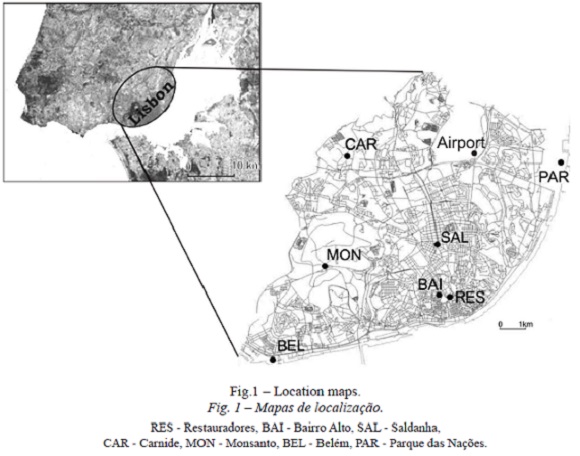
Following previous studies of Lisbon’s climate (Alcoforado, 1992; Andrade, 2003; Lopes, 2003), a mesoscale meteorological network was set up in 2004 to monitor Lisbon’s UHI, under the guidance of Professor Timothy Oke. These studies are still ongoing, combining observations and modelling. The preliminary statistical results were published in 2007 (Alcoforado et al., 2007). Their main aim was to produce useful information for urban planning, which has been achieved in collaboration with Lisbon’s Municipality (Alcoforado et al., 2009).
The main goal of the current study is to update the results with new observational data and to present and analyse the basic statistics of Lisbon’s heat island. Data on the frequencies of occurrence and of the mean and maximum values of the UHI are essential to decide which urban planning measures should being taken (Eliasson, 2000; Oke, 2006).
The next section will provide some information about the urban canopy UHI; section iii will explain how data was acquired. In section IV the methodology used is described. The results are included in section V and discussed in section VI. The conclusions are presented in section VII.
II. URBAN CANOPY UHI
The urban thermal field is dependent not only on large scale (synoptic) factors (Berenová and Huth, 2005; Morris et al., 2001) through the change in cloudiness and regional wind field, but also on local natural features (such as the topography or the presence of large water bodies) as well as on urban morphology. This means that at any given time the urban thermal field is the result of the combined effects of the synoptic, natural and urban features, as expressed by the Lowry (1977) equation 1:

Where M is the value assumed for a given climatic variable in the urban site x, at the time t and under the weather type i; C is the regional component (determined by large scale features); L stands for the natural local features and U is the urban component. The urban parameter (U) may be explained through the analysis of the urban energy balance. The following equation 2 was proposed by Oke (1988)

Q* is the net all-wave radiation and QF the anthropogenic heat flux. QH is the flux of sensible heat, QE the flux of latent heat, ΔQS is the heat stored in the urban fabric and ΔQA represents the net heat advection (Wm-2)



K↓ is the short wave solar radiation, K↑ the reflected short wave radiation, L↓ the longwave sky radiation and L↑ the longwave terrestrial radiation loss.
We include in this paper a brief summary of the differences of urban and rural energy balance, and a discussion of the modification of the different terms of the energy balance following Oke (1996), Mills (2004), Grimmond (2007), among many others. It should be remembered that values vary from city to city and within each city.
K↓ may be 10% lower than in the country and up to 30% in cities with high levels of pollution due to the high concentration of aerosols (Jáuregui and Luyando, 1999). However, K↑ is frequently lower in the city which is partly due to canyon geometry (Oke, 1996): the reflecting area is large and multiple reflexion between walls in urban areas of low sky view factors (SVF) cause a lower outward shortwave radiation (K ↑). Besides, surface materials may also modify the albedo (e.g. dark surfaces reflect less energy) and further decrease K ↑. Lopes (2003) showed that the albedo is lower in Lisbon than at the periphery (except in Monsanto Hill). As a result K * may be similar in urban and rural areas or even higher in urban areas. As to longwave radiation, L↓ may be increased in urban areas due to air pollution and dust longwave emission and the longwave lost to the atmosphere L ↑ may be reduced due to low SVF. So L * will possibly be higher in urban areas, which means that there will be greater absorption and re-emission of longwave radiation (Grimmond, 2007).
As a result, radiation budget (Q*, eq. 3) will be higher in urban areas.
The anthropogenic heat flux (QF) is higher in cities due to electricity and combustion of fossil fuels, air conditioning and heating systems, factories, vehicles and even heat from human metabolism (sailor and Lu, 2004). This parameter is very difficult to compute and the magnitude of the flux depends on the scale of the analysis. It varies a lot from city to city (depending on the latitude, the industrialisation degree, social-economic development among other factors), within the city and in time (e.g. higher in winter in mid-latitude cities). Its proportion within the energetic balance depends also on the population density (which varies a lot during the day). Part of (QF) is directly emitted in the urban canopy layer (traffic, air conditioning systems).
The energy input (Q*+ QF) is used in different ways in urban areas:
In many cities, the areas covered by vegetation are lower than in the country and the cities have much more impervious areas. As a result, there is a decrease in evapotranspiration (latent heat flux QE). Then, the energy driving evapotranspiration is lower in the city and there is more energy available to warm up the air (QH, sensible heat flux). The sensible heat flux is defined by Oke (1996) as “that heat energy able to be sensed (e.g. with a thermometer)”.
The surface materials’ thermal characteristics have particular “radiative properties (albedo and the emissivity), as well as conductive properties (thermal admittance and conductivity)”, as Grimmond (2007) pointed out, which influence the surface temperature and heat storage (ΔQS). In most cases, heat stored during the day is transferred by night to the urban atmosphere. Studies conducted in Lisbon have shown that the ratio QS/Q* attains 55% in the more densely built part of the city (southern city districts), versus 1.2% in the airport and the forested hill in western Lisbon (Lopes and Vieira, 2001).
Finally, the advection factor (ΔQA ) is the neat heat advection. The wind speed decreases in the city due to surface roughness caused by the buildings. This has been verified in Lisbon by Lopes et al. (2011) and will be discussed below.
In conclusion, UHI can be controlled by a large set of factors the most important of which are the modification in radiation balance, the emission of anthropogenic heat, the reduction in evapotranspiration from vegetation and soils, the thermal accumulation in buildings and pavements and the reduction of average wind speed (Oke, 1996; Arnfield, 2003).
III. MONITORING LISBON UHI
1. First networks
The first studies carried out in Lisbon were based on itinerant temperature and humidity measurements (Alcoforado, 1992). The same route was repeated circa 60 times, using an Assman Psycrometer to measure temperature and humidity at 1.5 m above the ground. Alcoforado (1992) calculated a mean UHI intensity of 2.5ºC and described night-time (higher) UHI and the fact that during the day, there are “cool islands ” in southern Lisbon either due to the sea-breeze (in the warm semester) or to winter radiation fog from the Tagus estuary. Some spatial interpolation experiments were carried out (Alcoforado, 1994).
Later, an early mesoscale network was temporarily set up and was the basis of Henrique Andrade ’s PhD thesis (Andrade, 2003). The 12 sensors were accurate Gemini Data Loggers’ Tiny Talks (Alcoforado and Andrade, 2006). Andrade’s (2003) work was also based on data from a microscale network in a city district in northern Lisbon (Andrade, 2003 and Andrade and Alcoforado, 2008). Among other results, Andrade (2003) confirmed and further studied Lisbon’s thermal patterns, developed the spatial interpolation processes, constructed rather detailed thermal maps, and initiated the study of human bioclimatology of Lisbon.
2. Permanent mesoscale network
In 2004, a permanent mesoscale network of 7 Geminy temperature and humidity data loggers (model TinyTag Plus) was set up under the framework of the ClimLis project. The devices were fixed to lamp posts at a height of approximately 3.5 m and at a distance of nearly 1 m from the post’s surface, hence avoiding its thermal influence (fig. 2).
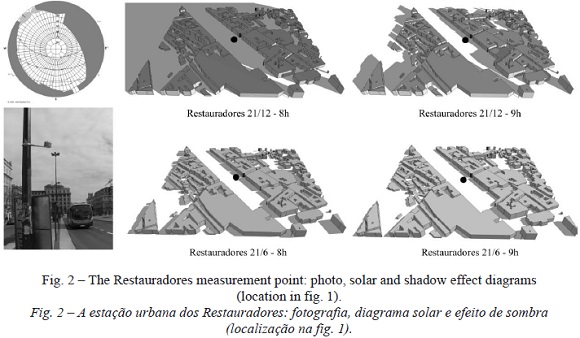
Records were made at 15 minute intervals, but only the average values over each hour period were analysed. In this paper 13,000 days from 2004 until 2012 are examined.
The sensors were disseminated as regularly as possible within the city. Two sensors were located near the Tagus River (BEL, PAR), one on Monsanto Hill (MON), three in the city centre (RES, BAI, SAL) and one in the northern boundary of Lisbon (CAR). The sites’ geographical characteristics are included in table I and their location shown in figure 1. Their altitude varies from under 10 m (BEL and Par) right on the Tagus Bank to 160.8 m (MON). The altitude of RES, SALD and CAR rises as their distance from the river increases. Bai, located on a southern hill of Lisbon, was installed later (2005) and will not be included in this analysis. The percentage of builtup area (measured within a 500 m square, centred over the observation site, Alves and Biudes, 2013) is the highest in res, BAI and SAL and is next to 0 in MON. The measurement sites are relatively open places, all of them with SVF >0.69 (Andrade, 2003), avoiding the influence of microclimatic factors, since the main objective was the study of the mesoscale thermal field (Oke, 2006). In order to interpret the results, each measuring point was characterized as exemplified in figure 2 for res, a measuring point within the CBD. Solar and shadow effect diagrams show that although RES is in the city-centre, it stays in the shade only until just before 9:00 h, even in winter. Monthly/hourly shadow effects are displayed in figure 7.
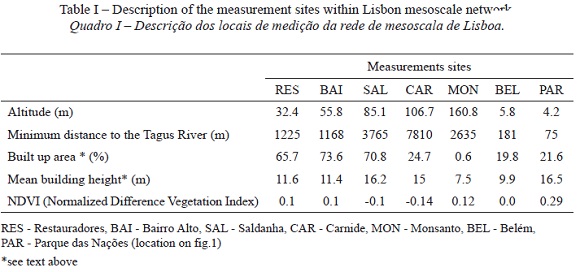
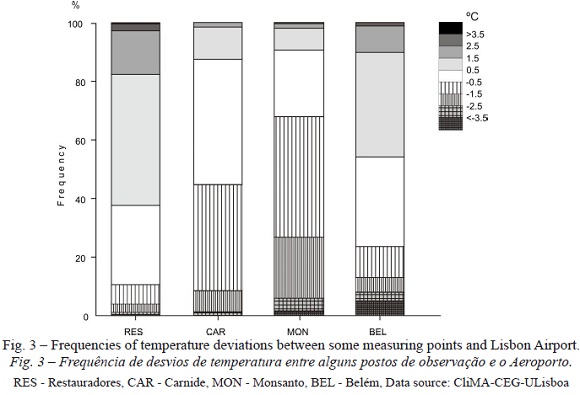
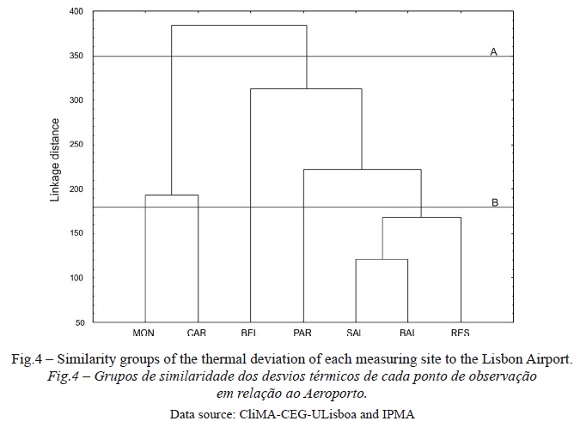
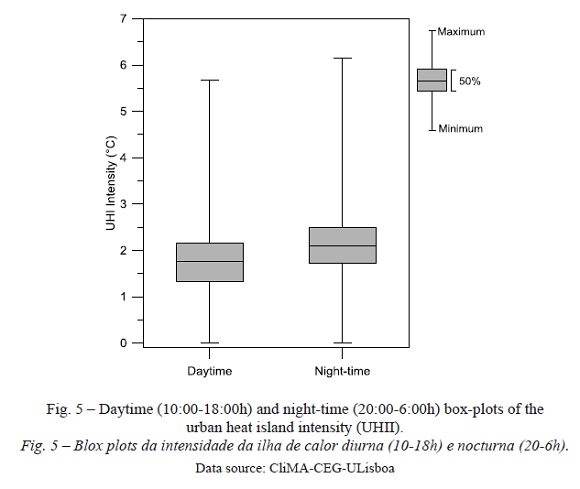
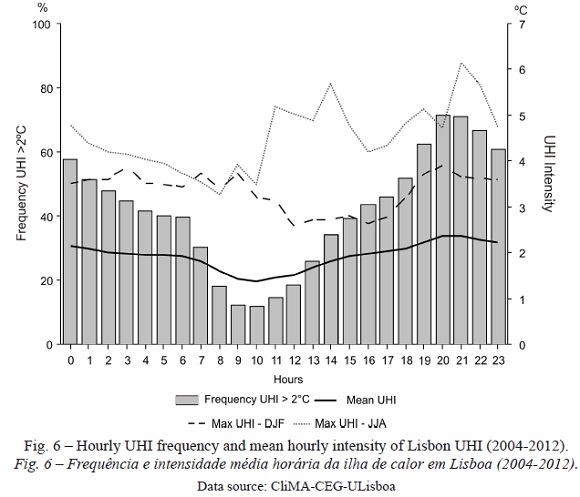
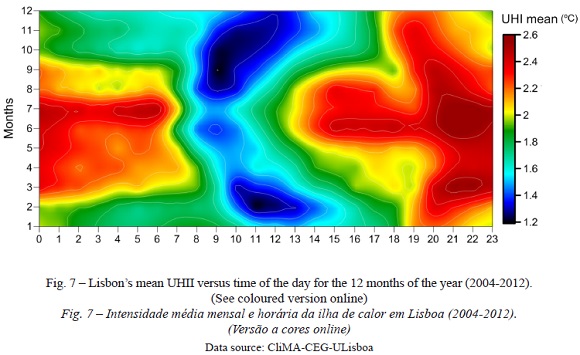
A temporary microclimatic network was also installed in one city-district (Telheiras, northern Lisbon) in order to determine the influence of street orientation, buildings’ shape, height to width ratio (Landsberg, 1981), presence/absence of trees and traffic on temperature, humidity and wind (Andrade, 2003; Lopes, 2003; Andrade and Alcoforado, 2008; Alcoforado, 2010a). However, the results will not be dealt with here.
IV. METHODOLOGY
The urban heat island results from the fact that “the air in the urban canopy is usually warmer than that in the surrounding” (Oke, 1996: 288). Following the same source the difference between the “peak” temperature in the city centre and “the background rural temperature defines the urban heat island intensity” (Oke, 1996: 289). This seems quite simple.
However, it is difficult to find universal criteria to calculate the UHI intensity (UHII). In different studies, authors calculate UHI intensities in very different ways. As pointed out by steward (2010) special attention should be given to site selection and temporal resolution of data. Hourly data are used in the current study. Furthermore, the data from the different sensors located in urban and sub-urban areas, following T. Oke’s rules (2006), were analysed in order to select appropriate sites to UHI calculation and three procedures were carried out.
1. Thermal similarities among city measurement sites
1.1. Comparison of thermal characteristics of measuring sites
First of all, the number of times each measuring point was the hottest or the coldest was counted and the frequency of both occurrences was calculated. it is clear from table II, that the more central measuring points (RES, BAI, SAL) are the hottest ones by night (sum of the bold figures on column 4: 96.4%) and by day (sum of the bold figures on column 4: 83.37%). CAR and MON are nearly always the coldest ones (sum of the italic figures on column 3 and 5, respectively: 99.7% by night and 83.6%). it is interesting to note that MON (on the forested hill, but in a site with high SVF) has a much higher frequency of coldest nights (92.8%) than Car (6.9%).
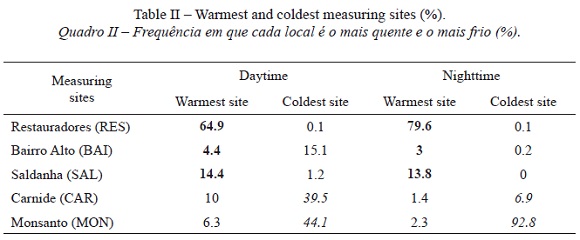
1.2. Temperature deviations from the Airport
Then we calculated for each location the percentage of hourly temperature deviations between that site and the Lisbon airport, located in the northern part of the city (fig.1). The airport had already been used as a reference station in early urban climate studies of Lisbon (Alcoforado, 1992), because it is in a windward situation towards Lisbon in the very frequent situations of n winds (Lopes et al., 2011).
Some results are plotted in figure 3. The white part of the columns correspond to situations with slight temperature deviations (0.5ºC<ΔT<+0.5 ºC); the grey scale corresponds to positive deviations (ΔT>+0.5ºC) when the city is hotter than the Airport; the stripes relates to negative deviations (ΔT <0.5ºC), when the city is cooler than the airport. RES (fig. 1 and 2) is hotter than the airport in more than 60% of the hours ( ΔT >+0.5ºC), 20% of which superior to +1.5ºC and 3% superior to +2.5ºC. Saldanha (SAL, not shown) is hotter than the airport in 45% of the hourly intervals, that is 15% less than res, probably due to its more north exposed site than Res. Saldanha’s square lays within the ventilation path through a large n-s street (Alcoforado et al., 2009).
The frequency of positive deviations (ΔT >+0.5ºC) decreases in the peripheral sites: 15% in CAR and 10% in MON. This site, located in a forested urban hill in western Lisbon, has the highest frequency (70%) of negative deviations to the airport, 10% ΔT lower than 2.5ºC and 3% ΔT lower than 2.5ºC.
In CAR, 45% of the deviations are lower than -1.5ºC. BEL has a relatively high percentage (55%) of positive deviations (ΔT >+0.5ºC) to the Airport, most probably due to its position in SW Lisbon, more directly submitted to warmer ocean air in the winter semester. Negative deviations (ΔT <0.5ºC) attain circa one fourth of the cases, due to the advection of cooler summer air.
1.3. Classification of measuring points based on their thermal deviations to the Airport.
Next, a tree clustering analysis (based on the linkage distance) of the thermal deviations between urban stations and the airport was carried out. The results are expressed on the dendrogram in figure 4. MON and CAR, the peripheral stations, are isolated from the five other more central stations, as expected (level a). Detailing the analysis (lower linkage distance, level B), the three stations of the city centre (RES, SAL and BAI) form a group, separated from the two riverside measuring points.
In view of these results, RES and SAL were used as “central city measuring points” (BAI had a shorter measuring period) and Car and MON were used as peripheral sites. The riverside areas (BEL and PAR) were not considered in this analysis owing to the influence of the Tagus River and the Ocean (particularly summer sea breezes and winter radiation fogs), that in these two particular sites may overlap the urban effect (Sakakibara and Owa, 2005; Alcoforado, 1992; Alcoforado et al., 2006). Their particular thermal behaviour is reflected in their separation from the central sites on the dendrogram (BEL and PAR in fig. 3).
2. Criteria to calculate UHI intensity
Following Oke (1996) and Andrade (2003) and based on the comparisons described above, the occurrence of the UHI in Lisbon was considered each time the temperature in the central sites (SAL and RES) was higher than the temperature registered in the peripheral locations (MON and CAR). The intensity of the UHI (UHII) was calculated as the difference, at a specific moment, between the central and the peripheral sites following the equation:
UHII = TC – TP (1)
Where TC corresponds to the highest air temperature of the two central sites, and TP the lowest air temperature of the peripheral sites.
IV. RESULTS: DAILY AND MONTHLY VARIATION OF LISBON’S UHI
The data was divided into night-time (20:00-6:00h) and daytime observations (10:00 to 18:00h), discarding the times close to sunrise and sunset, when the radiation conditions can cause thermal anomalies due to the shadowing of the facets.
In figure 5, the median UHI is slightly lower by day (1.6ºC) than by night (2.1ºC). The first quartile is higher by night (1.7 versus 1.3ºC by day), as well as the third quartile (2.5 versus 2.2ºC by day). Maximum UHII during the studied period is 6.3ºC (by night) and 5.7ºC (by day). However, these slight differences hide great temporal and spatial differences, which further analysis will unveil.
Figure 6 discloses more details related to daily variability of air temperature in Lisbon. First of all, it is clear that the frequency of UHII >2ºC is lower from 9 to 11a.m. (<20% of the cases). It increases during late afternoon and attains its maximum value around 20-21:00h (70% of the cases) and diminishes slowly towards dawn. This is quite similar to the general scheme explained by T. Oke (1996) and discussed below. The mean UHII, however, does not show such a great daily variation, although it is lower during the day (1.8ºC) than in the evening and night (2.0ºC). The values are very close to the median, displayed in figure 5, which denotes a symmetrical distribution. Nonetheless, maximum UHII is reached in summer afternoons and more so in the evenings (up to 6ºC). In winter, maximum UHII fluctuates between 3 and 4ºC, slightly higher in the evening than in the afternoon.
Finally, figure 7 plots UHII at different times throughout the whole year, showing large differences. The lower daytime UHII occurs earlier and lasts less in summer than in winter. The night-time maximum is higher and lasts longer during the summer months. The afternoon evening increase of UHII (more than 2º C) in summer begins much earlier (14:00h) than the winter one (circa 19:00h). In the discussion, these findings will be put into context and further explained.
V. DISCUSSION
The urban climate is quite specific to each city. nevertheless, the Mediterranean cities have a fair amount of points in common (Montávez et al., 2000; Santamouris, 2007; Kolokotsa et al., 2009): an evening/night-time maximum occurs in most cities; maximum UHI takes place in the summer (except for Barcelona, Moreno-Garcia, 1994) and afternoon cool island may occur due to shadow effect, storage of energy inside buildings (ΔQs) and in several cities to the occurrence of seabreezes, as in nice (Carrega, 1992) and Marseille (Lemonsu et al ., 2006).
In Lisbon, summer UHII values are the highest (mean values of 2.6ºC, as mentioned above). nocturnal maximal is caused by different factors, such as heat released by the buildings (ΔQs), more anthropogenic heat (QF) released into the atmosphere, eventually less latent heat released (Qe) by dew formation, less heat used for evapotranspiration (also Qe) and in some cases higher radiation balance (Q*, less outward longwave radiation due to low sky-view factors). This last factor is probably less important in Lisbon, because both res and SAL measuring sites are set in areas with sky-view factors >0.69. Lisbon’s UHI is also due to shelter from cold (in winter) and cool (in summer) prevailing north winds in the valley beds and lower altitudes of the southern part of the city (which coincides partly with the CBD, fig. 8).
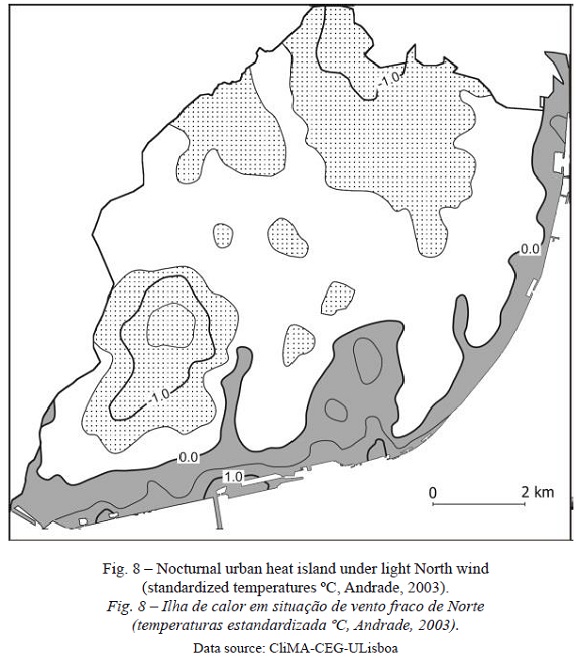
One very interesting feature in figure 7 is the fact that, in summer, high UHII begins quite early in the afternoon, which can be explained by the wind regime in the city (Alcoforado, 1987; Lopes et al., 2013). in the summer mornings, there are frequently e and SE breezes from the Tagus estuary that veer to the s and SW by midday or later, bringing cooler air into the river-site city centre, sometimes up to res (Andrade, 2003) and in summer cause a negative heat island from 9:00h to 12:00h (or later). This negative heat island does not appear in the mean values, but it is clear from several study-cases (Alcoforado et al., 2006). In the afternoon, at least in 40% of the cases, the sea-breeze is replaced by north gradient wind. During the time the north wind is blowing, the southern and central part of the city is sheltered and a positive UHI develops quite early (15 h or even earlier, fig. 7).
The relationship between UHII and wind has been studied and verified recently by Lopes et al . (2013). The plots of UHII versus wind speed show an expected reduction of UHI intensity when wind exceeds 4 m/s (fig. 9). However, UHI still persists and its intensity may reach 2ºC under wind speeds of 18 m/s. This is due to the shelter effect, mentioned above. It is interesting to note that with wind speeds above 12 m/s UHII is never close to 0, meaning that the shelter effect is really important. Some authors do not consider this factor to cause a real UHI (stewart, 2010). However, it is difficult to separate the different causes and shelter effect is not only caused by topography but also by high-rise buildings, so it is a result from city morphology. This dual effect is discussed in Andrade et al. (2010).

The maximum UHII in Lisbon does not occur in calm situations, following the general rule (Oke, 1996), but with light winds, where shelter effect accumulates with urban causes and may generate UHII up to 6 ºC (fig. 9). In very light wind situations (below 2 m/s) UHII decreases (maximum circa 4ºC). This is explained in the summer by sea-breeze situations, bringing fresher air to the down-town area and in winter by the occurrence of foggy situations. The relationship between UHI and wind direction is not so clear and is discussed in Lopes et al. (2013).
We are aware that statistical analysis has weaknesses, particularly the inability “ to present several physical phenomena” (Mirzaei and Haghighat, 2010). Moreover, there are generally a limited number of stations and of meteorological parameters measured, not always for a long period of time, necessary to “filter the unpredictable errors” (idem). However, measurements are necessary to validate numerical or physical models and we have now a relatively long series of urban measurements; furthermore, measurement points have been selected with tight criteria following Oke (2006).
VI. CONCLUSION
In this research work, more details and statistical information about Lisbon´s thermal climate are divulged, now based on hourly data from 8 years (2004-2012) of the Mesoscale Measurement Network of the CliMa research group. For science sake and for urban planning procedures, it is essential to identify the frequency of the Lisbon UHI to decide if (and which) adaptation measures should be applied.
The areas with higher temperatures occur in the “Baixa” (res site) and the “Avenidas Novas ” (SAL site). Nevertheless, there is a great spatial and temporal variability of the UHII. This paper concentrates on its temporal variability. The median UHII varies from 1.5ºC in summer to 2.1ºC in winter. Maximum values may attain circa 6ºC in summer afternoons, evening and nights. Minimum frequencies of UHII >2ºC, as detected in this research, correspond to the time spanning from 8:00 to11:00 h. This is only partly due to shadow effect, as we have verified that at least after 9:00 h there is direct solar radiation on the measuring sites (fig. 2 shows the example of res measuring point). During the morning, energy is stored within the buildings (ΔQs) and air temperature is generally lower than in nonurban open spaces. Maximum values occur during the night, particularly in the summer when, among other factors, ΔQs is released to the urban canopy layer, after sunset and during part of the night. The maximum UHII in Lisbon does not occur in calm situations but in light wind conditions, where shelter effect accumulates with urban causes and may generate UHII up to 6ºC.
This paper is focused on temporal variability of Lisbon’s UHII. The current data set is also being used in a paper (in preparation) updating the study of Lisbon’s spatial thermal patterns.
BIBLIOGRAPHY
Alcoforado M J (2010a) Assessing and modelling the urban climate in Lisbon. In Carrega P (ed.) Geographical Information and Climatology. ISTE & WiLey, London & Hoboken: 125-158. [ Links ]
Alcoforado M J (2010b) Climatologia urbana para o ensino. CliMa, 3, CEG, Lisboa. [ Links ]
Alcoforado M J (1994) L’extrapolation spatiale des donn ées thermiques en milieu urbain. Publications de l’Association Internationale de Climatologie, 6: 493-502. [ Links ]
Alcoforado M J (1992) O clima da região de Lisboa. Contrastes e ritmos t érmicos. Memórias do CEG, Lisboa, [ Links ] 15.
Alcoforado M J (1987) Brisas estivais do tejo e do oceano na região de Lisboa. Finisterra – Revista Portuguesa de Geografia, XXII(43):71-112. [ Links ]
Alcoforado M J, Andrade H (2008) Global warming and urban heat island. In Marzluff JM, Shulenberger E, Endlicher W, Alberti M, Bradley G, Ryan C, Simon U, Zumbrunnen C (eds.) Urban Ecology. Springer: 249-262. [ Links ]
Alcoforado MJ, Andrade H (2006) Nocturnal urban heat island in Lisbon (Portugal): Main features and modelling attempts. Theoretical and Applied Climatology, 84(1-3): 151-159. [ Links ]
Alcoforado M J, Andrade H, Lopes A (2010) Clima e ordenamento urbano na escala microclimática: o exemplo do bairro de Telheiras em Lisboa. In Figueiredo et al. (eds.) Clima e recursos naturais. Instituto Politécnico de Bragança: 43-82.
Alcoforado M J, Andrade H, Lopes A, Vasconcelos J (2009) Application of climatic guidelines to urban planning the example of Lisbon (Portugal). Landscape and Urban Planning , 90: 56-65. [ Links ]
Alcoforado M J, Andrade H, Lopes A, Oliveira S (2007) A ilha de calor em Lisboa. Aquisição de dados e primeiros resultados estatísticos para aplicação ao ordenamento urbano. In Centro de Estudos Geográficos CEG (ed.) Geophilia - o sentir e os sentidos da Geografia. Homenagem a Jorge Gaspar: 593-612. [ Links ]
Alcoforado MJ, Andrade H, Lopes A, Vasconcelos J, Vieira R (2006) Observational studies on summer winds in Lisbon (Portugal) and their influence on daytime regional and urban thermal patterns. Merhavim, 6: 90-112. [ Links ]
Alves EDL, Biudes MS (2013) Method for determining the footprint area of air temperature and relative humidity. Acta Scientiarum. Technology, 35(2): 187-194. [ Links ]
Andrade H (2003) Bioclima humano e Temperatura do ar em Lisboa (Human Bioclimate and Air Temperature in Lisbon). PhD in Physical Geography, University of Lisbon, Lisbon. [ Links ]
Andrade A, Alcoforado M J, Canário P (2010) estimação da influ ência antrópica no campo térmico de Lisboa; uma tentativa de modelação estatística. II Workshop Internacional sobre Clima e Recursos Naturais nos Países de Língua Portuguesa. Bragança: 207-214. [ Links ]
Andrade H, Alcoforado M J (2008b) Microclimatic variation of thermal comfort in a district of Lisbon (Telheiras) at night. Theoretical and Applied Climatology, 92(3-4): 225-237. [ Links ]
Arnfield J (2003) Two decades of urban climate research: a review of turbulence, exchanges of energy and water and the urban heat island. International Journal of Climatology, 23:1-26. [ Links ]
Beranová R, Huth R (2005) Long-term changes in the heat island of Prague under different synoptic conditions. Theoretical and Applied Climatology, 82: 113-118. [ Links ]
Carrega P (1992) Topoclimatologie et habitat. Thèse d ’État, Université de nice, [ Links ] nice.
Eliasson I (2000) The use of climate knowledge in urban planning. Landscape and Urban Planning, 48: 31-44. [ Links ]
Gabriel K M A, Endlicher W R (2011) Urban and rural mortality rates during heat waves in Berlin and Brandenburg, Germany. Environmental pollution, 159 (8-9): 2044-2050. [ Links ]
Grimmond S (2007) Urbanization and global environmental change: local effects of urban warming. Cities and global environmental change: 83-88.
Já uregui E, Luyando E (1999) Global radiation attenuation by air pollution and its effects on the thermal climate in Mexico City. International Journal of Climatology, 19(6):683-69. DOi: 10.1002/(Sici)10970088(199905)19:6<683::aiD-JOC389>3.0.CO;2-8 [ Links ]
Kolokotsa D, Psomas A, Karapidais E (2009) Urban heat island in southern Europe: the case study of Hania, Crete. Solar Energy, 83: 1871-1883. [ Links ]
Landsberg HE (1981) The urban climate. Elsevier science. [ Links ]
Lemonsu A, Pigeon G, Masson V, Moppert C (2006) sea-town interactions over Marseille: 3D urban boundary layer and thermodynamic fields near the surface. Theoretical and Applied Climatology, 84(1-3):171-178. DOi: 10.1007/s00704-005-0155-y [ Links ]
Lopes A (2003) Lisbon climate modification due to the urban growth wind, surface heat island and energy balance. PhD in Physical Geography, University of Lisbon, Lisbon. [ Links ]
Lopes A, Vieira H (2001) Heat fluxes from Landsat images: a contribution to Lisbon urban planning. Regensburg Geographische Schriften, 169-173.
Lopes A, Saraiva J, Alcoforado M J (2011) Urban boundary layer wind speed reduction in summer due to urban growth and environmental consequences in Lisbon. Environmental Modelling & Software, 26(2): 241-243. [ Links ]
Lopes A, Alves E, Alcoforado M J, Machete R (2013) Lisbon urban heat island updated: new highlights about the relationships between thermal patterns and wind regimes. Advances in Meteorology, Vol.2013, iD487695:11, doi.org/10.1155/2013/487695
Lowry WP (1977) Empirical estimation of urban effects on climate: a problem analysis. Journal of Applied Meteorology, 16: 129-153. [ Links ]
Memon R A, Leung D y C, Chunho L (2008) a review on the generation, determination and mitigation of urban heat island. Journal of Environmental Sciences, 20: 120-128. [ Links ]
Mills G (2004) The urban canopy layer heat island. IAUC teaching resources. http://www.urban-climate.org/UHI_Canopy.pdf (accessed on March 20th 2014).
Mills G (2003) The meteorological utopian city revisited. 5th international Conference on Urban Climate, Lodz: 4p (CD). [ Links ]
Haghighat F (2010) Approaches to study urban heat island e abilities and limitations. Building and Environment, 45: 2192-2201.Montavez J, Rodriguez A, Jimenez J (2000) A study of the urban heat island of Granada, International Journal of Climatology, 20: 899-911. [ Links ]
Moreno-Garcia MC (1994) Intensity and form of the urban heat island in Barcelona, International Journal of Climatology, 14: 705-710. [ Links ]
Morris C J G, Simmonds I, Plummer N (2001) Quantification of influences of wind and cloud on the nocturnal urban heat island of a large city. Journal of Applied Meteorology, 40:169-182. [ Links ]
Oke T R (2006) Initial guidance to obtain representative meteorological observations at urban sites World Meteorological Organization.instruments and Observing Methods, report no.81,WMO/tD.no.1250, Geneva, Canada. https://www.wmo.int/pages/prog/www/IMOP/publications/IOM-81/IOM-81-UrbanMetObs.pdf . (acedido em 26 de Março de 2014).
Oke T R (1997) Urban climates and global environmental change. In Thompson R D, Perry A (eds.). Applied Climatology. Principles and pratices. routledge, London: 273-287. [ Links ]
Oke T R (1996) Boundary layer climates. 2nd ed. routledge, London. [ Links ]
Oke T R (1988) the urban energy balance. Progress in Physical Geography, 2(4): 471-508 [ Links ]
Sailor D J, Lu L (2004) a top-down methodology for developing diurnal and seasonal anthropogenic heating profiles for urban areas. Atmospheric Environment, 38: 2737-2748. [ Links ]
Sakakibara y, Owa K (2005) Urban-rural temperature differences in coastal cities: influence of rural sites. International Journal of Climatology, 25: 811-820. DOi:10.1002/ joc.1180 [ Links ]
Santamouris M. (2007) Heat island research in Europe - state of the art. Advances in Building Energy Research, 1: 123-150. [ Links ]
Stewart I D (2010) a systematic review and scientific critique of methodology in modern urban heat island literature. International Journal of Climatology. 31: 200-217. DOi:10.1002/ joc.2141 [ Links ]
Tan J, Zheng Y, Tang X, Guo C, Li L, Song G, Zhen X, Yuan D, Kalkstein AJ, Li F (2010) the urban heat island and its impact on heat waves and human health in shanghai. International Journal of Biometeorology , 54(1): 75-84. [ Links ]
United nations (2012) World urbanization prospects: the 2011 revision. CD-ROM edition - Data in digital form (POP/ DB/WUP/rev.2011). http://esa.un.org/unup/CD-rOM/Urbanrural-Population.htm (accessed on December 15th, 2013). [ Links ]
Zhang K,Wang R, Shen C, Da L (2010) temporal and spatial characteristics of the urban heat island during rapid urbanization in shanghai, China. Environmental monitoring and assessment, 169(1-4): 101-112. [ Links ]
Received: December 2013. Accepted: July 2014.
ACKNOWLEDGEMENTS
the research was carried out in the frame of CliMa research group of the Centre of Geographical studies, institute of Geography and spatial Planning, University of Lisbon. The mesoscale urban network was set up in the frame of the ClimLis project (POCti/34683/GeO/2000), under the guidance of Prof. tim Oke. We dedicate this paper to Henrique Andrade (1960-2013) who was a great enthusiast of this project and was responsible for this network until his untimely death. thanks are due to several students who contributed to the setting of the network (rute Vieira, João Vasconcelos and Hugo Vieira) and its maintenance (Paulo Canário, sandra Oliveira, raquel Machete, Wenzel Vermeersch, Max anjos, David Marques and Miguel freire Correia). The authors acknowledge the reviewers for their comments that greatly contributed to improve the final version of this manuscript and would also like to thank the Fundação de Amparo à Pesquisa do Estado de S ão Paulo, Brazil (faPesP) for the 9 month grant offered to Elis Dener Lima alves (pr. 2012/20598-5), who treated most of the new data during his stay in Lisbon in 2013/14.
NOTES
i Other references in Alcoforado and Andrade (2008)














